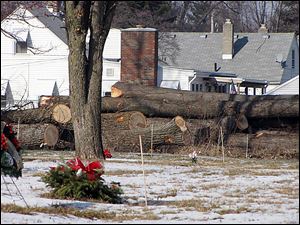
Casket firm clears trees at Toledo cemetery
Historic Woodlawn land to be developed later
3/14/2013
Logs waiting for transport by crews from Care Caskets of Wharton, Ohio, sit along the north border of Historic Woodlawn Cemetery. Woodlawn is removing hundreds of trees on the grounds.
In Toledo’s Historic Woodlawn Cemetery, trees are being used to create products that will help celebrate the lives of the dead, in the form of environmentally friendly caskets.
The north side of the cemetery on West Central Avenue recently has undergone substantial tree removal, as part of a continuous master plan for the cemetery.
“Looking into the future of the cemetery, we identified multiple areas within the cemetery that we could potentially develop,” Will Sloane, associate director of Woodlawn, said. He added that the cemetery is hoping to use the cleared land as a green space and then develop the land a few years down the road.
“It was really an area that had been underdeveloped over the course of the history of the cemetery,” Mr. Sloane said, adding that he had a forester assess the trees and found that many, of multiple varieties, including oak and maple, were dying on the north side. “We’re going to be identifying areas that we can replant. We’re an arboretum. We’re obviously pretty concerned about that side,” Mr. Sloane said. The majority of trees in the area are volunteer trees, he said, meaning that they haven’t been planted by humans and they just appear in spots.
“It just kind of got out of control, as it wasn’t really utilized — a lot of poison ivy and a lot of different stuff back there,” he said.
When the trees are removed, Care Caskets of Wharton, Ohio, will take the wood away and turn it into caskets. Care Caskets previously has had an influence in the Sylvania area.
“Our Sylvania model is named after the Sylvania Country Club,” President Brad Laking said of one of the company’s caskets.
Removing the trees from Woodlawn also will help the cemetery save resources, since Care Caskets will handle the removal. Company officials did not provide any figures for the work, but said the partnership is saving money.
Mr. Laking said the caskets are made from reclaimed and repurposed lumber. “Death is a very difficult situation,” he said. “Care Caskets is really trying to do something to make it more human.”
Mr. Laking said his company has had the unique opportunity to remember the lives of the dead, while also saving the environment.
“We have really tried to make a product that can celebrate somebody’s life,” he said. The company tries to emphasize that it makes the absolute minimum impact to the environment, because it handpicks trees.
“We can go into a field of, say, 30 acres, and handpick trees that are infected, and use them while they’re still useful. Because we do one at a time, it’s unique that we don’t just wipe it out. We found it to be efficient enough to go in and save what shouldn’t be touched,” Mr. Laking said.
After removal, the trees are taken to the company’s facility near Findlay and the trees are cut into the lumber that is needed. Then the lumber is air-dried and another company is responsible for using a kiln to further facilitate the drying process. It takes about six to eight weeks to make a tree from the cemetery into a casket, Mr. Laking said.
Other elements of the caskets are sustainable. The interiors are made out of 100 percent natural cotton. The company is also a member of the Green Burial Council.
Mr. Sloane said the partnership has worked out well and that the community has responded postively to seeing the area start to be cleared out. Interested residents were invited to attend two meetings before trees started being taken down. “We were just lucky enough to be undergoing this project and hopefully being able to reuse the wood and use it in an environmentally friendly way. The community has been great. Before we started the project, we reached out to the immediate community around us. They’ve had just a really great understanding of the project.”
But at the core of the project is the dedication to turn a tree that has perished into something greater.
“We don’t cut down a good tree,” Mr. Laking said. “We’re a part of our community and we’ve proven it.”
Contact Kelly McLendon at: kmclendon@theblade.com or 419-724-6522, or on Twitter @KMcBlade.